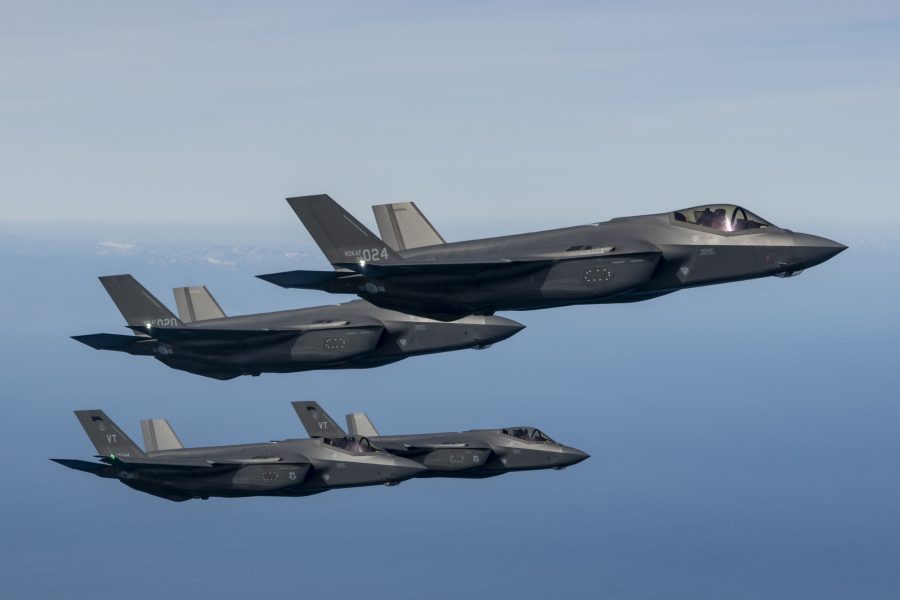For months now, a big number has been attached to the F-35: $2.1 trillion.
That’s the new estimated lifetime costs for the program, a massive sum that has become an oft-cited figure in coverage about the fighter.
Now, the F-35 Joint Program Office is trying to put context around that number, releasing a “clarification” April 8 explaining those costs.
In a press release, the program office noted that the $2.1 trillion F-35 program estimate, which came to light last spring, is an all-inclusive figure covering 94 years of procurement of an eventual 2,456 aircraft, development, upgrades and modifications, spare parts, operating costs, personnel, the depot enterprise and even fuel, among other expenses. It also includes foreign investment.
Asked why it issued the statement, a JPO spokesperson told Air & Space Forces Magazine that Air Force Lt. Gen. Michael Schmidt, the program executive officer, “asked our team to work through a cost narrative to clarify information that he has seen in numerous reports (both internally and externally). He wanted to provide a breakdown of costs and provide context directly from the program.”
The breakdown comes at a potentially tenuous moment for the F-35.
The Pentagon and Office of Management and Budget are putting the finishing touches on the fiscal 2026 defense budget request, and President Donald Trump’s administration has given no overt indication of how it views the F-35’s place in the budget. While Trump himself has been complimentary of the program, his close adviser Elon Musk, who oversees the “Department of Government Oversight” commission, has derided the program as an obsolete “jack of all trades, master of none,” and a victim of a “broken” requirements process. Musk has for several years touted the position that uncrewed, autonomous aircraft are the future of military aviation.
On April 7, Trump said the 2026 defense budget would, for the first time, eclipse the $1 trillion mark, a major increase.
After the budget is revealed, the Senate and House Armed Services Committees typically hold hearings on fixed-wing tactical and training aircraft, and such hearings are often dominated by discussion of the F-35’s costs.
Finally, the JPO and Lockheed Martin reached a preliminary agreement on Lot 19 of the F-35 in late 2024, saying the specific costs of the three F-35 variants in the lot will be revealed when the contract is finalized. The JPO has said that will happen in spring 2025. No announcements have yet been made.
Amid all of this, press reports have frequently referred to the F-35 as the “$2 trillion fighter,” a sobriquet the JPO wished to address.
The program release, titled “Providing the Facts Behind the $2T Number,” noted that the Pentagon’s 2023 Modernized Selected Acquisition Report quoted a $2.1 trillion estimate “over [the F-35’s] 94-year life cycle, from 1994 through 2088,” and that this “comprehensive estimate” reflects not only the U.S. investment in the program, but that of its 10 original international partners, as well.
“This figure accounts for all costs associated with the development, production, and sustainment of the F-35 air system,” the JPO said, noting that it must make an educated guess on such mercurial figures as inflation and fuel prices more than 53 years into the future.
Included in the cost estimate:
- The full development, procurement, and modernization of 2,456 production aircraft by 2049 across the U.S. Air Force (F-35A), U.S. Marine Corps (F-35B and F-35C), and U.S. Navy (F-35C)
- The establishment of depot repair capability to support organic operations
- Initial spares and sustainment operational support
- Military and civilian personnel costs
- Fuel, aircraft repairs, software maintenance, modifications, and other support services
- Inflation adjustments spanning the entire 94-year life cycle. Notably, the F-35 program uniquely captures a 40-year forecast of through-life development costs at the outset, “a first-of-its-kind approach for a program of this scale.”
About half the $2.1 trillion estimate is inflation, the JPO noted. The overall figure is “calculated in ‘then-year’ dollars, meaning it is inflation-adjusted to reflect the projected value of money over the program’s 94-year span. Around $1 trillion of this total is influenced by inflationary effects over the years.”
The JPO said three main factors drive the program’s cost. The first is “scale,” as the F-35 is “set to become the largest single air system procurement in DOD history, with thousands of units planned for production.”
The second is concurrency: “The program’s 40 years of development and modernization, along with simultaneous efforts in development, production, and sustainment, contribute to its increased complexity and cost.”
The third factor is “duration.”
“The long-term nature of the program, spanning nearly a century, results in significant inflationary effects. This unprecedented scale, along with the simultaneous management of development, production, and sustainment, underlines the scope of the F-35 program and its associated costs.”
The F-35’s cost is likely to be an important consideration in final budget deliberations, as the Air Force pursues development of the F-47 Next-Generation Air Dominance fighter, development of which is expected to cost about $20 billion through the end of the decade. The Navy is also expected to pursue its own next-gen fighter, called F/A-XX, and a contract is nearly ready for award, according to reports.
It’s not clear whether each service’s fighter portfolio will have room for both aircraft, as well as the autonomous Collaborative Combat Aircraft which will partner with all current and future crewed fighters, even with the defense budget increase Trump said is coming.
